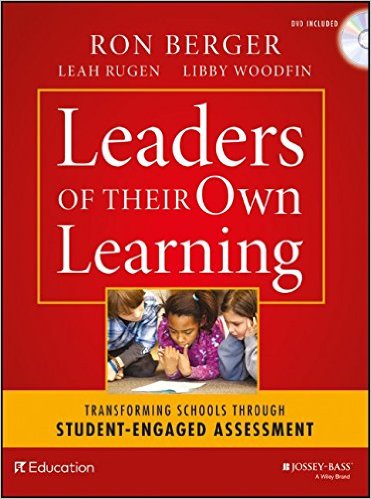How to Help Students Own Their Learning
Leaders of Their Own Learning: Transforming Schools Through Student-Engaged Assessment
By Ron Berger, Leah Rugen, and Libby Woodfin
(Jossey-Bass, 2014 – Learn more)

Some books are best read slowly. We savor every page because the ideas being expressed are evocative and thoughtful. Leaders of Their Own Learning is one of these books.
Ron Berger and his colleagues prod each of us to reflect on our teaching practice. They provides tips, encouragement, real classroom examples, and gentle nudges that guide teachers to enhance classroom practice and student learning. Leaders of Their Own Learning is an ambitious book, which fits me well since “ambitious” is my One Little Word (OLW) for 2016.
Talking to the book

This book is divided into eight sections highlighting key practices that revolve around the big idea that engaging students in their own assessment process is a powerful way to transform teachers, students, classrooms and entire schools.
I couldn’t agree more. Although this is not a new idea – educators have been promoting student reflection through metacognitive and self-assessment activities for a long time – Berger, Rugen and Woodfin break down this concept into explicit student events that put kids in the driver’s seat.
“Student-engaged assessment is a system of interrelated practices that positions students as leaders of their own learning.” (p. 2).
According to the authors, when we engage students in a variety of self-assessment activities they begin to take ownership of their learning. None of these events alone will do this. However, all of them in concert will create self-directed learners. Assessment, then, is not merely a tool to determine growth; it serves as a means of motivating students to want to learn more.
Since students silently assess themselves all the time, it makes sense to formalize this “silent” assessment by making it public and intentional, guided by learning targets or standards. In order for this to happen, teachers need to provide students with specific, targeted feedback. If this is a schoolwide effort, then the impact will be far reaching.
To help readers consider schoolwide implementation of student-engaged assessment, each chapter describes “what to expect” at different stages of the implementation process. There are also inserts throughout the book detailing case studies and examples of what this teaching and learning looks like in the classroom.
Companion videos provide additional classroom vignettes that illustrate the various strategies and student events described in the book. And, finally, there are bonus web materials to provide further assistance and support for teachers embarking on this journey.
Learning Targets
The focus of chapter one, “Learning Targets,” is on creating learning targets or student-friendly statements that address learning goals. These are best written as “I can…” statements describing what students can do. For example, “I can write complete sentences.” A cognitive shift happens when learning targets are written as affirmations. This places student focus on the goal or target of the learning as something that’s already happening.
This is a powerful mindset move, which I try to replicate in my own classroom. Although the authors often refer back to the Common Core State Standards (CCSS), the source of the learning targets can be locally determined. What’s more important than which learning targets are being used is that they be well articulated and student friendly, serving to “transfer ownership for meeting objectives from the teacher to the student,” (p. 21).
Checking for Understanding
In chapter two, “Checking for Understanding During Daily Lessons,” the focus is on helping students to think about the purpose of the learning at all times so that they can set goals and regularly assess themselves. Students practice a variety of strategies to “monitor and articulate their progress toward learning targets and guide teachers toward adjustments in instruction to ensure that all students understand the material and are able to meet [them],” (p. 15).
Some examples of strategies teachers can use to check for student understanding are writing and reflection; student-discussion protocols; quick checks; strategic observation and listening; and debriefs. For example, teachers can ask students, ‘How will you know if you understand this well? What might you be able to do or show to demonstrate understanding?’” (p. 59). Of course, students must feel safe and supported in the classroom if they are to talk freely about their learning progress.
Using Data
In chapter three, “Using Data with Students,” teachers and students use data in intentional ways to improve teaching and learning. I think data has become a dirty word for many teachers who are being negatively evaluated based on their students’ standardized test results. The attention being given to standardized tests is crowding out other more reliable sources of information (data) about what and how students are learning.
For me as a classroom teacher, my biggest take away from this chapter is that we need to give students clear and specific feedback about how they are doing with respect to learning targets, and to help them understand different kinds of data and what they tell us about learning. Although there are several warnings in this chapter regarding the importance of data and student privacy, I think this is an essential consideration when dealing with student data on a classroom wide basis.
Models, Critique and Feedback
In chapter four, “Models, Critique and Descriptive Feedback,” teachers help students use “models or exemplars”, “descriptive feedback” (p. 134) and “critique lessons” (p. 134) to improve their work. These three components provide students with a standard of excellence to which they can compare their work. As a doctoral candidate, I find my supervisors share examples of what quality writing looks like at different stages of the doctoral journey. Although this takes time, which is often in short supply, it is helpful in the long run to have an idea of what you’re aiming for. This teaches students that all work can always be improved and that we can refer to examples that meet standards of excellence to help us on this journey.
“Within a student-engaged assessment system, we start with learning targets, which put the standards in concrete terms that students understand. Students should then be provided with models that make those targets come to life. Finally, they should analyze those models to build a shared understanding of what makes them effective,” (p.136).
Student-Led Conferences
In chapter five, “Student-Led Conferences,” the big take away is that students must be taught how to reflect on their learning. And, of course, this starts with setting goals to accurately determine learning. To be honest, this chapter has the fewest mark ups since I have been doing student-led conferences for many years now. However, I appreciate the authors’ attention to the details of how to set up student-led conferences, such as determining purpose and preparing students and parents before, during and after the conferences. If students and parents are prepared and informed about the expectations and purpose of student-led conferences, they will be more effective.
Celebrations of Learning
In chapter six, the spotlight is on Celebrations of Learning, those times when student learning is celebrated in a public space beyond the classroom. There are a lot of excellent ideas and examples for how to do this sprinkled throughout this chapter. As with other chapters in the book, the authors address all the details of celebrations of learning, including the role of the teacher, the audience and the student during the celebrations.
For example, the authors give an example of how parents can “rate” students’ work based on specific criteria related to learning targets. Finally, it’s important to debrief the entire process of the celebration of learning with students. No matter what experiences students have in the classroom, without the process of reflecting on those experiences, their learning will not be long lasting.
Passage Presentations
In chapter seven, “Passage Presentations with Portfolios,” are public events that demonstrate learning over a longer chunk of time and take place at key transition points in a student’s school career. What differentiates passage presentations from portfolios and celebrations of learning is that the former are intended as rites of passage from elementary to middle school and middle school to high school, for example.
Furthermore, passage presentations with portfolios include a panel of experts who may ask questions and assess the work of students. The authors provide guidance regarding how to set up the expert panels, including their purpose and the extent of the panels’ influence.
My grade 5 students have the Primary Years Program (PYP) Exhibition near the end of 5th grade. However, we don’t have expert panels judging the work our students have done. It seems fitting that before moving to 6th grade there would be an expert panel to offer outsider views of the work students have done. I will be thinking about how to implement this with my students as a way to impact their learning.
Standards-Based Grading
Standards-Based Grading (SBG) is the topic of the last chapter and one that I feel strongly about. Much has been written about the superiority of a SBG system. In fact, there is a Twitter chat devoted to the topic of SBG and (Standards-Based Learning) #SBL. The following quotes from Leaders of their Own Learning address some key ideas about SBG.
“We simply can’t know what a traditional grade means because it doesn’t provide enough information about what students are learning or what they need to do to improve,” (p.302).
This is where learning targets and goals are helpful for both students and teachers: student “grades” are determined by how close they are to meeting particular standards – exceeding, meeting, approaching, not yet.
“Academic grades are no longer an average of student performance over a grading period, but a measure of whether or not they can show mastery at its closure,” (p.303).
What is emphasized here is the importance of learning, no matter when it happens. Rather than a series of semester grades that get averaged into a final grade, students are evaluated based on a final demonstration of learning, whether that is a test, a project, or something else. It cannot be emphasized enough that learning should be evaluated at the end of a learning cycle, not in the beginning or the middle. Although this seems to be common sense, it is not an easy idea to sell to teachers or parents.
“In a traditional system, time is fixed and learning is flexible. In a standards-based system, learning is fixed and time is flexible,” (p. 345).
The “what” of the learning is determined at the beginning of a cycle. The “when” is not set in stone.
A resource for all classrooms
Leaders of Their Own Learning is a book that deserves a prominent place in all classrooms. I know that I will refer to the many excellent ideas found within its pages. Every time I open it up I find another simple, but brilliant, suggestion I can use to improve my teaching and the learning of my students. Put this book on your to-buy list now and then read it from cover to cover…more than once. You won’t regret it.
Editor’s note: The complete collection of Leaders of Their Own Learning videos are available free at Vimeo.
________________
Elisa Waingort has been teaching in bilingual settings for more than 25 years in public and international schools in North and South America. She is currently teaching grade 5 at Academia Cotopaxi, an American International School in Quito, Ecuador. Elisa blogs at A Teacher’s Ruminations. She has uncovered the power of Twitter and is growing her PLN by leaps and bounds. Her professional and classroom Twitter handles are @elisaw5 and @mselisacoto, respectively.































I enjoyed your review. I will plan to purchase the book. It sounds like a keeper.